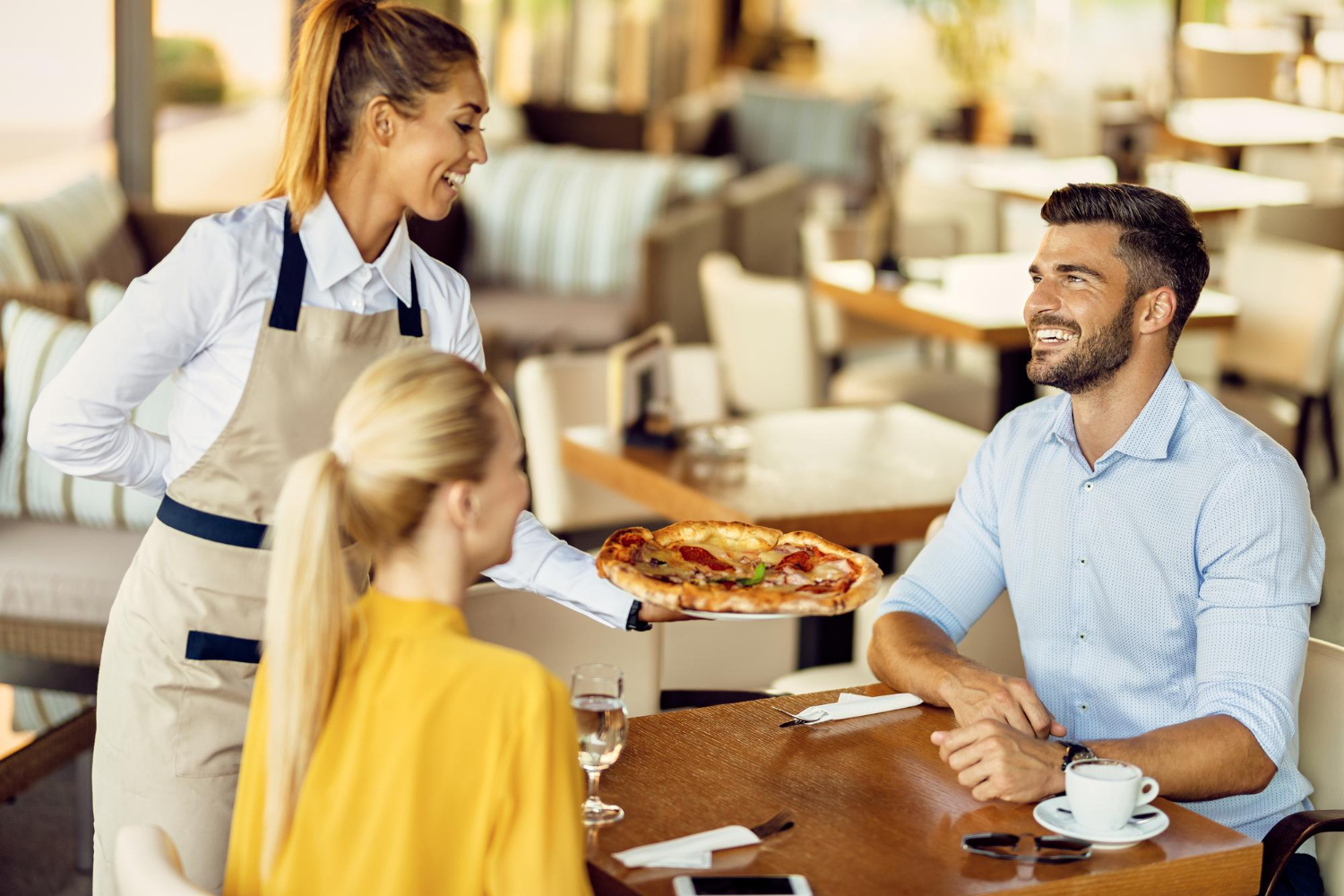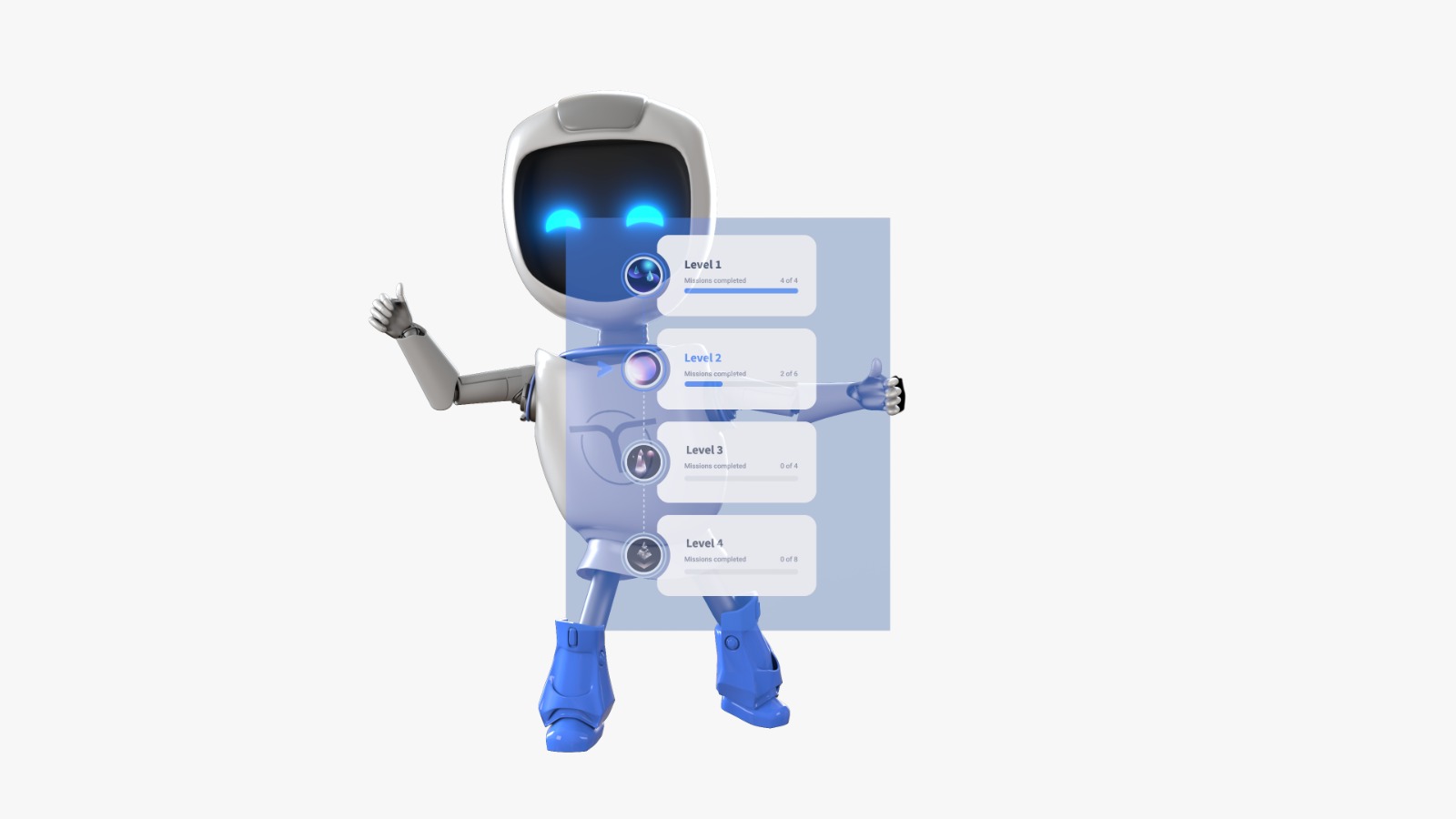Every guest remembers when they feel welcomed and respected, and more so when they are not. That’s why hospitality customer service training is more than a routine, but a foundation for creating genuine connections. With 96% of global consumers linking good customer service to brand loyalty, the way your team interacts can define your reputation. A study by EHL has also shown that well-trained teams consistently deliver 5%+ more in revenue and see guest satisfaction climb by up to 7%.
In this article, we’ll explore what effective hospitality customer service training looks like: from the key hospitality skills your team needs, to the methods that actually work, and how to measure training results. Whether you’re building a new program or refining an existing one, these insights can help elevate every guest interaction.
Key Skills Taught in Hospitality Customer Service Training
At the heart of every outstanding guest experience is one essential goal: connection. In fact, 64% of consumers say they want brands to connect with them, not just transact. In hospitality, that connection is built through a blend of interconnected customer service skills that go far beyond a friendly smile.
Hospitality customer service training helps your team develop these skills so they can create genuine moments that reflect the spirit of your brand.
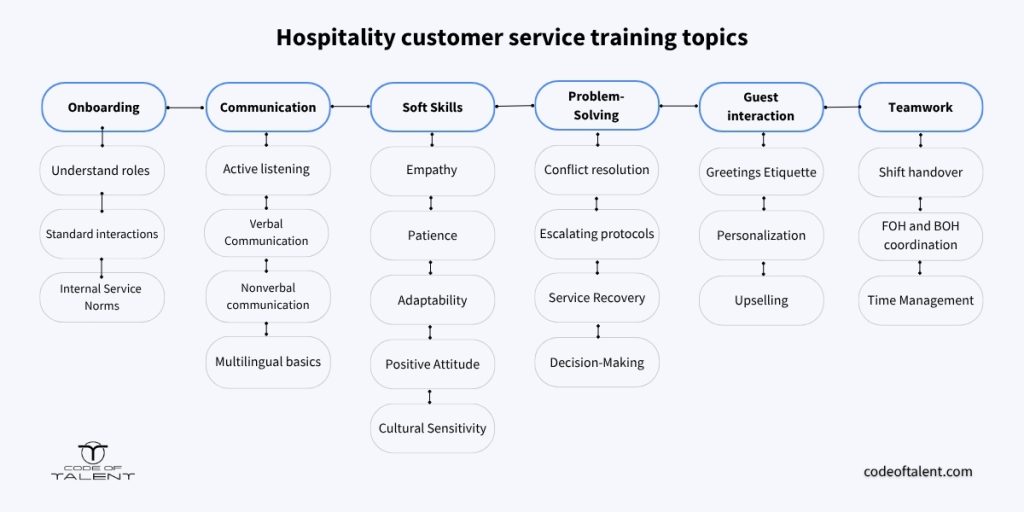
1. Good Service Starts with Good Onboarding
The first days on the job shape how staff understand their role and how well they interact with guests. A strong onboarding program is the foundation of excellent service.
Understand Every Role
New team members should get familiar with more than just their own responsibilities. A quick walkthrough of other roles helps them:
- Know who to go to for what
- Jump in to help when things get busy
- Work better as a team
Introduce Standard Interactions
If your brand uses scripts, greetings, or opening lines, introduce them early. They give new hires a head start on:
- Speaking confidently with guests
- Maintaining brand voice and consistency
- Avoiding awkward first impressions
Define Internal Service Norms
Every hospitality brand has different expectations for guest engagement. For example, certain restaurants encourage servers to ask if guests want a drink within the first minute, while others find this practice intrusive.
2. Communication Skills
Clear and effective communication is the backbone of exceptional hospitality service, and data proves it. According to Smith Travel Research, properties with strong communication skills can command 8-12% higher average daily rates. Here are the key communication skills hospitality teams need to master:
Active Listening
Listening doesn’t only mean hearing words, but understanding the guests’ needs and emotions. Active listening means giving full attention to the conversation, asking clarifying questions, and responding accordingly.
Examples of clarifying questions:
- “Just to make sure I understand, you’d prefer a quiet table by the window. Is that right?”
- “So you’d like your room cleaned after 3 PM. Does that work for you?”
- “To confirm, you’d like a taxi arranged for 7 AM tomorrow morning?”
Clear Verbal Communication
Speaking politely and clearly helps guests feel respected and understood. Additionally, the right words can even help de-escalate tense situations, turning frustration into cooperation.
Effective communication training should cover:
- Speaking loudly enough to be heard, but never shouting or sounding aggressive
- Slowing down the pace
- Using a friendly and warm tone
- Avoiding jargon or technical terms
Nonverbal Communication
According to research, people form lasting impressions in the first two minutes, largely based on body language like posture, eye contact, and gestures. Positive nonverbal cues build trust, often before a single word is spoken. In hospitality, this silent language plays a huge role in making guests feel welcomed and comfortable.
For practical tips on how to improve body language in customer service, check out our in-depth article: How to Fix Body Language in Customer Service
Multilingual Basics
Learning simple greetings and phrases in guests’ common languages, especially English, can make a big difference in connection and comfort. It shows effort and respect toward diverse visitors.
Quick tip: Start with “hello,” “thank you,” and “how can I help you?” in common languages your guests speak.
3. Emotional Intelligence and Soft Skills
When designing hospitality customer service training, soft skills and emotional intelligence deserve focused attention, as these are often the defining factors in guest interactions. Unlike technical tasks, though, they can’t be taught with checklists or manuals.
They require practice, reflection, and real-world simulation. That’s why the most effective way to build emotional intelligence is through experience-based training: role-plays, scenario-based exercises, and reflections.
Empathy
Empathy allows staff to connect with guests emotionally, especially in moments of stress or vulnerability. It’s about reading between the lines and offering comfort or assurance when it’s needed most.
Pro Tip: Create a scenario where a guest has had a delayed check-in after a long trip. Ask trainees to role-play both the guest and the staff side. Then follow up with a short writing mission: “Recall a time when you felt misunderstood as a customer. How could empathy have changed that experience?”
Patience
Hospitality is a fast-paced and unpredictable industry. Training for patience helps staff remain calm, especially when guests are frustrated or when operations are under pressure.
Pro Tip: Use time-pressured simulations where multiple guest requests come in at once. Observe how staff manage pacing and tone under stress. In the debrief, ask: “What part of the scenario tested your patience most, and how did you manage it?”
Adaptability
Last-minute requests, VIP arrivals, menu changes, or unexpected delays are daily occurrences. Staff must be able to shift priorities without compromising service quality.
Pro Tip: Design a “curveball” scenario. Begin with a basic task (e.g., greeting a guest), then suddenly change the situation (e.g., room type unavailable, family with dietary needs). Ask trainees afterward: “What surprised you in this simulation? What helped you stay flexible?”
Positive Attitude
In hospitality, a positive mindset helps staff recover quickly from setbacks, motivate each other under pressure, and create an uplifting atmosphere for guests. Guests pick up on energy quickly, and positivity is one of the easiest things to pass along.
Pro Tip: Run a reflection-based group activity: “Think of a time when a positive coworker lifted the mood at work. What did they do, and how did it affect you and the guests?”
Cultural Sensitivity
Cultural sensitivity means recognizing that guests bring their own customs, values, and expectations into every interaction. What feels friendly in one culture may seem too casual, or even inappropriate, in another. In hospitality, cultural missteps can quickly lead to discomfort, awkward situations, or lost trust, even if unintentional.
Pro Tip: Build scenarios involving guests from different cultural backgrounds. Follow with a reflection: “Have you ever been in a situation where cultural differences led to miscommunication? How would you handle it differently now?”
4. Problem-Solving and Conflict Resolution
No matter how well-trained a team is, problems will arise. What matters most is how your staff responds: calmly, quickly, and with the guest’s experience in mind. Here are four key areas to include in your hospitality customer service training:
- Conflict Resolution: Teach staff how to stay calm when guests are not. Training should include how to lower the emotional temperature by using a calm tone of voice, maintaining open body language, and validating guest concerns without assigning blame.
- Reporting and Escalation Protocols: Not every situation should be handled at the front line. Staff need to know the chain of command: who to contact, when to loop in a supervisor, and how to document incidents properly.
- Service Recovery Protocols: Mistakes are bound to happen even with the best operational and management system, but great service recovery can turn a bad experience into a positive one. Training should cover how to apologize sincerely, offer solutions, and follow up.
- Decision-Making Under Pressure: Encourage staff to make quick decisions without needing constant approval and gain autonomy in their work. The goal is to solve problems on the spot when possible, using sound judgment.
5. Guest Interaction and Personalization
In an industry that welcomes hundreds of guests each day, service can easily feel transactional. To guests, it might seem like the priority is just getting them checked in, served, and out the door.
But personalization changes that. It sends a different message: we see you, we value your presence, and your experience matters to us.
Greeting and Farewell Etiquette
The guest experience starts the moment they walk in, and how they’re welcomed (and sent off) can define how they remember your brand. Staff should master friendly greetings and goodbyes, with consistency across shifts.
Training Example: On day one of onboarding, create a short daily quiz on greeting/farewell standards across different guest types (families, business travelers, international guests).
Personalizing Service
Guests notice when small details are remembered, like their name, favorite drink, or birthday. Personalization builds connection, and it’s easier to train when staff learn to look for cues and anticipate needs.
Training Example: Run an “idea challenge” workshop. Ask team members to share one new, creative way to personalize service using only what’s available at your property (no budget required). Choose one or more ideas to implement that month.
Upselling with Care
Upselling is recommending what could make a guests’ stay more enjoyable and should feel helpful, but never forced. When done with empathy and timing, it adds value to their stay and increases revenue. A short sales training session for servers can go a long way in developing their upselling skills.
Training Example: Pair staff in role-play scenarios where one plays a hesitant guest and the other practices upselling based on specific cues (e.g., “It’s our anniversary”, then suggest a room upgrade or wine pairing). Give feedback on timing, tone, and language.
6. Teamwork and Internal Communication
Behind every excellent guest experience is a team that communicates well across shifts, departments, and busy service hours. No matter how skilled individual staff members are, if internal communication breaks down, service suffers. That’s why hospitality customer service training must include structured teamwork practices such as:
- Shift Handover Procedures: A smooth handover between shifts ensures nothing gets lost, like pending guest requests, VIP arrivals, or maintenance issues.
- Coordinating with Back-of-House: Communication between front-facing staff and teams like housekeeping, kitchen, or maintenance is essential for delivering good service. A breakdown here can lead to long wait times, double requests, or missed expectations.
- Time Management: Guests expect fast service, but staff often juggle many tasks at once. Training should help them prioritize and delegate tasks, stay calm under pressure, and know when to ask for support.
How to Deliver 5-Star Guest Experiences Through Training
Training is the first step to delivering the kind of service that earns guest loyalty. It gives your team the tools to meet high expectations and handle challenges with consistency. And loyal guests are good for business: increasing customer retention by just 5% can boost profits by 25% to 95%, according to Bain & Company.
In this section, we’ll break down the key areas (or principles) to focus on before designing a training program, as these are the foundations that lead to five-star service.
Defining What “5-Star” Really Means to Today’s Guests
The gold standard of service isn’t what it used to be. Today’s guests expect more attention to their needs, less mistakes, and an experience that makes them forget about the issues of day-to-day life, even for a few hours or days.
To deliver standout experiences, teams need to understand the evolving definition of “5-star”:
- Luxury means comfort and ease, not just formality.
- Personalization includes remembering preferences and tailoring offers.
- Speed matters, as delays can overshadow the whole stay.
- Problem-solving must be fast, empowered, and empathetic.
Training Tip: Develop a comprehensive checklist or manual that defines what a 5-star guest experience means, from the big picture down to small details like how to fold a napkin. Integrate this manual into a modern training platform like Code of Talent, which uses AI to transform your materials into interactive modules. For example, staff might watch a video demonstrating napkin folding, then submit their own photo or video as proof.
Training for Anticipation: Seeing Guest Needs Before They’re Expressed
Exceptional service often comes down to the things guests don’t have to ask for. Anticipation means recognizing needs before they’re voiced such as refreshing a drink before it’s empty or noticing when a family needs extra seating without being told.
To train this skill, reinforce the habit of scanning the environment, not just completing tasks.
What to include in training:
- Scenario-based practice for spotting cues (e.g., luggage tags, travel fatigue, dietary preferences).
- “What would you do?” group discussions based on real situations.
- Empowerment exercises: when and how to act without asking for approval.
Consistency Is Key: Aligning Frontline and Back-End Staff
5-star experiences are only possible when every team is in sync. A well-prepared concierge can’t deliver if housekeeping is delayed. A polished greeting loses power if the reservation wasn’t updated. Alignment is everything.
Training Tip: Build in cross-department simulations where staff must communicate across roles (front desk, housekeeping, food & beverage) to complete a mock guest journey.
Using Guest Feedback in Training Design
Guest reviews are one of the best training tools you have. Whether it’s a glowing 5-star comment or a frustrated complaint, feedback offers real-time insight into what’s working and what needs attention.
How to use it in training:
- Select real reviews (positive and negative) to discuss in team huddles.
- Use feedback to update training materials monthly.
- Involve team members in creating solutions to common complaints.
Pro Tip: Platforms like Code of Talent display real-time changes in customer reviews as a KPI for training. You can track how guest feedback evolves and see exactly how training is influencing online ratings, giving you a clear view of what’s working and what needs refining.
Hospitality Customer Service Training Methods That Work
Training in hospitality isn’t one-size-fits-all. Great guest service comes from consistent, well-designed learning experiences that reflect the nature of the industry. From mobile-first tools to coaching, here are the training methods that truly work on the floor.
1. E-Learning and Mobile Microlearning
Modern hospitality teams are busy, mobile, and often spread across shifts. That’s why training solutions today are designed to fit their pace: engaging, accessible, and built for real-life operations. eLearning and microlearning have become key tools in hospitality customer service training, turning learning into an ongoing experience rather than a one-time task.
Platforms like Code of Talent offer microlearning modules (bite-sized lessons staff can complete in minutes), right from their phones. It’s cost-effective, scalable, and ideal for reinforcing daily operations without pulling people off the floor.
Trainers can track engagement and completion in real time, while AI turns manuals into interactive tasks (quizzes, video prompts, or mini-missions) that improves information retention.
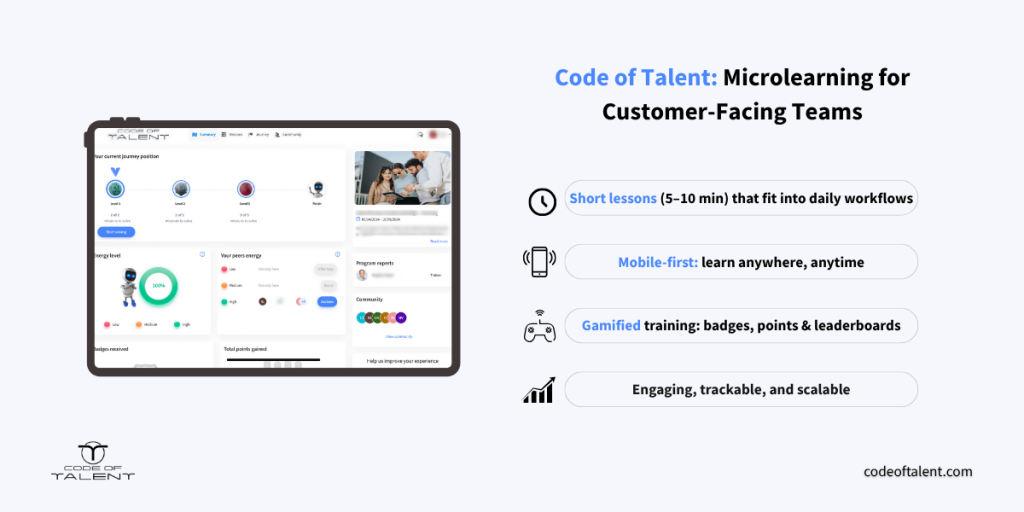
2. Theory vs. On-the-Job: Blending Learning Approaches
Some skills and operations, such as company policies, compliance and operational standards, menu updates, or service principles, need structure and theory. Others, like handling pressure or upskilling, require real-world practice.
The best training blends the two:
- Theory introduces core concepts.
- On-the-job shadowing and live practice turn those concepts into habit.
3. Interactive Formats
Our attention span has downgraded to 8 seconds, which makes any type of long-form content hard to understand and digest. This is why modern training platforms integrate more than 2-3 training formats and techniques. Code of Talent for examples, has 10 training types, as listed below.
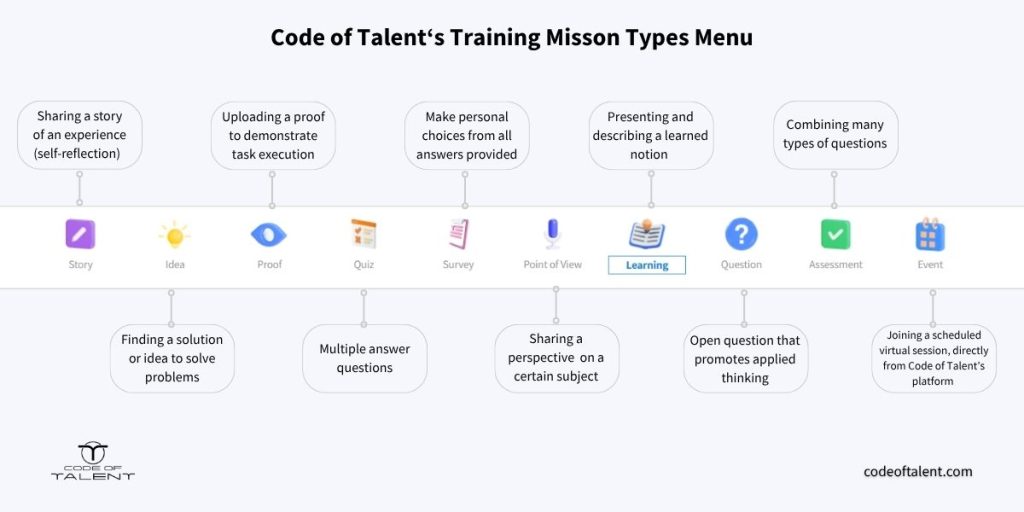
These 10 formats are based on simple learning techniques that blend both theory and practice:
- Role-playing: To practice in a safe environment.
- Scenario-based learning: To learn from different situations before they happen in real life.
- Quizzes & challenges: To reinforce information practically.
- Personal input: To share with others and learn from each other.
4. Peer Coaching and Team Debriefs
Create a culture where the team learns from itself. Encourage peer coaching, where experienced team members support new hires, and host quick debriefs after busy shifts or challenging situations. Discuss:
- What went well?
- What could we improve?
- Did anyone go above and beyond?
5. Customized Training Paths
No two job roles are the same, especially in hospitality. Some need help with upselling, others with communication or cultural sensitivity.
AI-powered platforms like Code of Talent use company data and information (such as menu details or safety and sanitary rules) and its own internal intelligence to create customized learning paths for each department and job function within an establishment.
Best benefit: Training facilitators spend less time on creating training materials. All they need to do is choose their need they want to improve with training and answer 4 questions. AI will generate the missions for them.
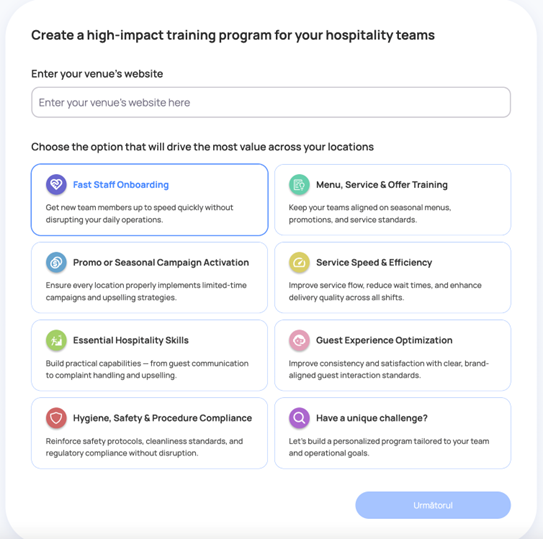
6. Recognition and Gamification
There’s no greater motivation to complete a task than recognition. Awarding employees for completing training modules and sessions improves their engagement and participation rates.
One of the best examples of recognition is gamification. Staff earn points, badges, or rankings for completing modules and quizzes.
And gamification can also lead to a real reward system. For example:
- The server with the most points this week gets to play their playlist during the closing shift.
- The first team member who completes a module streak earns a spa voucher, free lunch, or a book of their choice.
- The best performer of the quarter receives an additional day off.
Incentives don’t always have to be monetary. Sometimes the smallest, symbolic rewards can be the most motivating.
Hospitality Customer Service Training Done Right
Delivering outstanding guest experiences starts with well-trained staff who understand the true meaning of hospitality. By focusing on essential skills and using innovative, flexible training methods, you can create a culture where exceptional service becomes second nature.
To support this journey, platforms like Code of Talent offer practical tools that make training accessible, engaging, and measurable. Explore our free trial to see how you can bring your hospitality customer service training to the next level!

